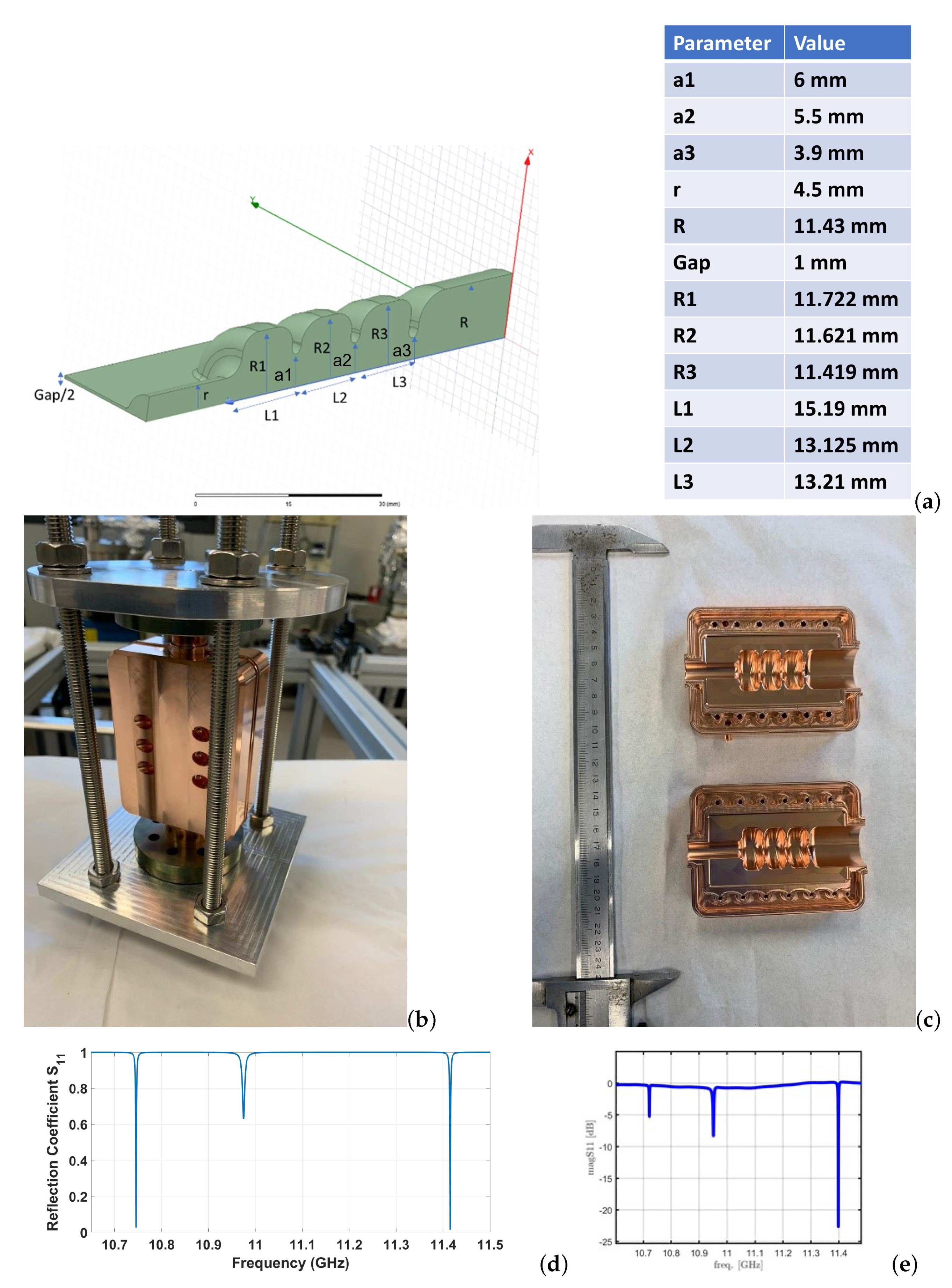A Hard Copper Open X-Band RF Accelerating Structure Made by Two Halves
1. Introduction
2. Low-Level RF Measurements
3. Possible Applications of Split Open Structures
4. Conclusions
Author Contributions
Funding
Institutional Review Board Statement
Informed Consent Statement
Data Availability Statement
Acknowledgments
Conflicts of Interest
References
- Dolgashev, V.A.; Faillace, L.; Spataro, B.; Bonifazi, R. Innovative compact braze-free accelerating cavity. J. Instrum. 2018, 13, P09017. [Google Scholar] [CrossRef]
- Dolgashev, V.A. High gradient, x-band and above, metallic rf structures. In Proceedings of the 2nd European Advanced Accelerator Concepts Workshop (EAAC 2015), Isola d’Elba, Italy, 12–19 September 2015. [Google Scholar]
- The Compact Linear Collider (CLIC). Available online: https://home.cern/science/accelerators/compact-linear-collider (accessed on 11 January 2022).
- Dolgashev, V.; Faillace, L.; Spataro, B.; Tantawi, S.; Bonifazi, R. High-Gradient RF Tests of Welded X-band Accelerating Cavities. Phys. Rev. Accel. Beams 2021, 24, 081002. [Google Scholar] [CrossRef]
- Hao, Z.; Grudiev, A. Design of the Compact Linear Collider main linac accelerating structure made from two halves. Phys. Rev. Accel. Beams 2017, 20, 042001. [Google Scholar]
- Zha, H.; Grudiev, A.; Dolgashev, V.A. RF design of the CLIC structure prototype optimized for manufacturing from two halves. In Proceedings of the 6th International Particle Accelerator Conference (IPAC 2015), Richmond, VA, USA, 3–8 May 2015. [Google Scholar]
- Comeb. Available online: http://www.comeb.it/ (accessed on 11 January 2022).
- Ansys. Available online: https://www.ansys.com/ (accessed on 11 January 2022).
- Geer, C.A.J.; Bakker, R.J.; der Meer, A.F.G.; Amersfoort, P.W.; Gillespie, W.A.; Saxon, G. Bunching of an intense electron beam extracted from a triode gun modulated at 1 GHz. Nucl. Instrum. Methods Phys. Res. Sect. A 1991, 307, 553–561. [Google Scholar] [CrossRef]
- Spataro, B.; Alesini, D.; Chimenti, V.; Dolgashev, V.; Haase, A.; Tantawi, S.G.; Higashi, Y.; Marrelli, C.; Mostacci, A.; Parodi, R.; et al. Technological issues and high gradient test results on X band molybdenum accelerating structures. Nucl. Instrum. Methods Phys. Res. A 2011, 657, 114–121. [Google Scholar] [CrossRef]

| Mode | Frequency [MHz] | Frequency [MHz] | Quality Factor (Q) | Quality Factor (Q) |
|---|---|---|---|---|
| (Two Halves) | (Closed Structure) | (Two Halves) | (Closed Structure) | |
| 0 | 10,749 | 10,760 | 10,520 | 10,615 |
| 10,979 | 10,984 | 10,213 | 10,306 | |
| 11,418 | 11,420 | 10,512 | 10,610 |
Publisher’s Note: MDPI stays neutral with regard to jurisdictional claims in published maps and institutional affiliations. |
© 2022 by the authors. Licensee MDPI, Basel, Switzerland. This article is an open access article distributed under the terms and conditions of the Creative Commons Attribution (CC BY) license (https://creativecommons.org/licenses/by/4.0/).
Share and Cite
Spataro, B.; Behtouei, M.; Cardelli, F.; Carillo, M.; Dolgashev, V.; Faillace, L.; Migliorati, M.; Palumbo, L. A Hard Copper Open X-Band RF Accelerating Structure Made by Two Halves. Instruments 2022, 6, 5. https://doi.org/10.3390/instruments6010005
Spataro B, Behtouei M, Cardelli F, Carillo M, Dolgashev V, Faillace L, Migliorati M, Palumbo L. A Hard Copper Open X-Band RF Accelerating Structure Made by Two Halves. Instruments. 2022; 6(1):5. https://doi.org/10.3390/instruments6010005
Chicago/Turabian StyleSpataro, Bruno, Mostafa Behtouei, Fabio Cardelli, Martina Carillo, Valery Dolgashev, Luigi Faillace, Mauro Migliorati, and Luigi Palumbo. 2022. "A Hard Copper Open X-Band RF Accelerating Structure Made by Two Halves" Instruments 6, no. 1: 5. https://doi.org/10.3390/instruments6010005
APA StyleSpataro, B., Behtouei, M., Cardelli, F., Carillo, M., Dolgashev, V., Faillace, L., Migliorati, M., & Palumbo, L. (2022). A Hard Copper Open X-Band RF Accelerating Structure Made by Two Halves. Instruments, 6(1), 5. https://doi.org/10.3390/instruments6010005










